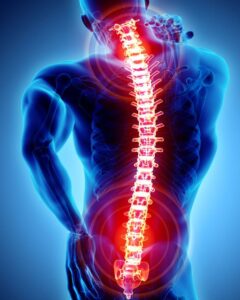
SCIATICA
Sciatica
Symptoms of sciatica describe leg pain, that may include numbness, weakness and tingling. The pain originates in the low back, through the buttocks and radiates down the sciatic nerve at the back of each thigh and leg.
The Sciatic nerve is the largest nerve in the human body. It is composed of nerve roots that start in the low back from the lumbar segment L3 to S4 of the sacral plexus and merge to form the sciatic nerve, in front of the piriformis muscle.
The sciatic nerve then branches out in the thigh and leg to innervate certain regions of the thigh, leg, foot and toes. It’s these nerve roots and nerves that specify the origin of pain.
Sciatic pain and symptoms can range from infrequent and irritating to severe and debilitating.
The leg pain is usually more severe than the low back pain and often described as burning or searing pain or electric shocks running down the leg. It usually affects only one side of the body.
Symptoms of Sciatica.
- Numbness or weakness when moving the foot or leg.
- Shooting pain in one leg, which makes it difficult to stand and walk.
- The pain eases when laying down, but worse when sitting or standing.
- Constant pain in buttocks and leg on one side, really on both sides.
- The pain starts in the low back and travels along the path of the nerve.
- Pain is sharp and searing, not a dull ache.
- Pins and needles, weakness, numbness or prickling feeling in the leg.
- The leg pain is more severe than low back pain.
Sudden movements such as coughing or sneezing and positional changes may aggravate the symptoms.
Symptoms are unique to the cause and origin of sciatica.
L4 nerve root: Affects the thigh. Weakness may occur when straightening the knee and diminished knee reflex.
L5 nerve root: Pain can radiate all the way to the big foot. Numbness may be felt on the top of the foot and between the great toe and second toe.
S1 nerve root: The outer part of the foot is affected, pain can radiate to the little toes. Weakness when standing on tippy toes, Ankle reflex may also be reduced.
If more than one nerve root is compromised then patients may have a combination of symptoms.
Causes of Sciatica
- Degenerative disc disease: Is a natural process that

Sciatica occurs with ageing. In certain individuals, one more degenerated discs in the lumbar spine can cause sciatica by irritating the associated nerve root.
- Sacroiliac joint dysfunction: When the sacroiliac joint is inflamed and irritated, it can aggravate the L5 nerve, which runs across the top of the SI joint resulting in a sciatic like pain. This is not true sciatica but the symptoms are a result of nerve irritation.
- Muscle strain: Inflammation due to muscle spasm ans strain in a lower lumbar muscle, can put pressure on a nerve root and cause sciatic pain.
- Piriformis syndrome: The sciatic nerve runs under the piriformis muscle in the buttocks. When the piriformis muscle is sprained or inflamed it can pinch or irritate a nerve root that is part of the sciatic nerve and cause sciatic like pain.
- Lumbar disc herniation: When a disc herniates the ruptured region can irritate and pinch the nerve roots. Sciatica is a common symptom of lumbar disc herniations.
- Pregnancy: As the body undergoes changes during pregnancy, such as weight gain, hormonal changes and a shift in the centre of gravity, it can cause sciatica during pregnancy.
- Scar tissue: After an injury, a build-up of scar tissue may occur. Known as epidural fibrosis, can compress a lumbar nerve Rott and cause sciatica.
